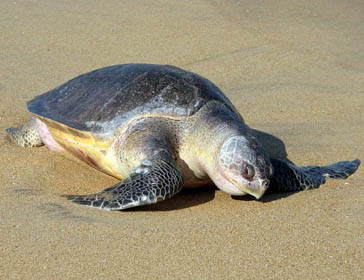Species at Risk: Sea Turtles
Green sea turtle (Chelonia mydas)
The green sea turtle is another important species in the Mediterranean. Along with the loggerhead turtle, green turtles are the ones most frequently found in bycatch or are involved in accidents with vessels. The IUCN classifies this species as “endangered” and it is included in the Habitats Directive, CMS and the Barcelona Convention. However, its state of conservation shows no clear signs of recovery. Dumping into the Mediterranean affects this species directly, but also has an impact on its habitats, food supply and reproduction, and is considered another factor, apart from bycatch, that hinders the recovery of this and other turtle species in Europe.
 Hawksbill sea turtle (Eretmochelys imbricata)
Hawksbill sea turtle (Eretmochelys imbricata)
Hawksbill sea turtles are in danger of extinction and are listed as endangered under the Habitat Directive and Barcelona Convention. Capturing and killing hawksbills for their valuable shell, which is used to make hairclips, combs, jewelry and decorative art , is a major threat to the recovery of the species. While the legal international trade of hawksbill shells ceased in 1994, Cuba has recently pushed to reopen the market.
The killing of hawksbills still occurs throughout the world for traditional, medicinal and subsistence level use. In the Pacific, intentional killing of sea turtles is a major issue in American Samoa, Guam, Palau, the Northern Mariana Islands, Micronesia and the Marshall Islands. And a number of American countries still allow the killing of hawksbills, including the British Virgin Islands, Cayman Islands, Cuba, Haiti and the Turks and Caicos Islands. Although the killing of hawksbills and the poaching of their eggs is illegal in the Dominican Republic and Jamaica, hawksbill products are still readily available for sale.
 Leatherback sea turtle (Dermochelys coriacea)
Leatherback sea turtle (Dermochelys coriacea)
In 1982, scientists estimated that there were 115,000 adult female leatherbacks worldwide. Recent estimates have placed the number between 20,000 and 30,000. The Pacific leatherback is in such severe decline that scientists believe they will become extinct in the Pacific Ocean within the next 30 years unless significant actions are taken to protect them very quickly. Incidental catch in fishing gear, poaching of their eggs and ingestion of plastics have all contributed to the listing of the leatherbacks as Endangered.
 Loggerhead sea turtle (Caretta caretta)
Loggerhead sea turtle (Caretta caretta)Loggerhead sea turtles are currently listed as being threatened with extinction under the Habitat Directive, Barcelona Convention and Convention of Migratory Species. Their numbers are rapidly declining. Loggerhead sea turtles, like other sea turtle species, face many natural and human-induced threats. Scientists have determined that the capture in fishing gear and the loss of nesting habitat are major causes of the loggerhead’s decline. Tens of thousands of loggerhead sea turtles are injured or killed annually in the Atlantic and the Gulf of Mexico by destructive fishing gear , including trawls, gillnets and longlines. Loggerheads are also captured and killed by commercial fisheries using vertical lines, seines, dredges and various types of pots and traps.
In the Atlantic Ocean, the majority of nesting occurs along the southeastern United States, but loggerheads also nest in the eastern Atlantic and western South Atlantic. All of the nesting populations in the Atlantic, with trend data available, are experiencing significant declines. The largest decline was experienced by the South Florida nesting population, which declined 40 percent in the past decade. It is long past time for the federal government to step up and take control of sea turtle takes (intentional or accidental human interactions), especially bycatch (the unintentional capture of turtles by fishing gear) and deaths in commercial fisheries. Failure of the fishery managers to act will immeasurably increase the risk of extinction of one of the ocean’s most ancient species.

Olive ridley sea turtle (Lepidochelys olivacea)
Olive ridley sea turtles, which are named for their olive-colored shell, are listed as threatened, with the exception of a single population that nests in Mexico, which is endangered. The decline of this species is primarily due to capture in commercial fisheries, loss of nesting habitat and continued killing of adults and poaching of eggs.

